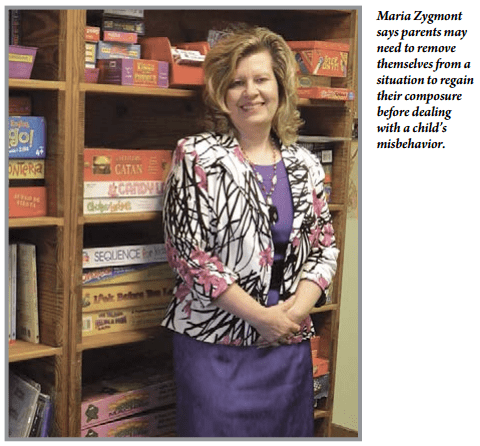Striking Situation – Studies Show Corporal Punishment Has Long-term Effects
Maria Zygmont says parents who spank their children or use corporal punishment don’t mean to harm them.
“Their intent is not to be violent — they do it out of love because they want their children to behave, be respectful, and learn from their teachers,” said the director of Brightside Home Based Services at Providence Hospital in Holyoke. “They don’t want them to take a wrong course in life, so they often do what was done to them during childhood.”
However, a national debate about corporal punishment ensued recently when Minnesota Vikings running back Adrian Peterson was indicted by a grand jury and charged with reckless or negligent injury to a child. The charges were filed after Peterson used a switch made from a tree branch and hit his 4-year-old son so hard, the boy was left with injuries all over his body.
Arguments over whether it is acceptable to strike a child continue, and although studies suggest it does long-term damage, surveys show most Americans believe in the practice due to their culture and/or religious beliefs.
Dr. Stephen Boos says America has one of the highest rates of religious observance in the world, and many parents think there is a command from God to spank their children. This belief, combined with Americans’ rigid assumption that children should be obedient, which contrasts with more permissive behavioral expectations in societies such as Europe and Japan, can lead to harsh discipline as well as a more accepting attitude toward it.
“Somalia and the United States are the only countries that have not signed the United Nations Charter on the Rights of the Child that says children should be protected from all physical harm,” said Boos, a pediatrician and medical director of the Family Advocacy Center at Baystate Children’s Hospital. “And due to cultural reasons, religious practices, and our beliefs about independence, the government does not believe it should interfere with the rights of parents, so many pediatricians are hesitant to take a hard stance on spanking.
“But the American Academy of Pediatrics says physicians should advocate discipline that does not include corporal punishment,” he went on, adding that the line between punishment and child abuse is crossed when the parent’s actions cause a physical injury, which includes bruises, scratches, cuts, pain, or discomfort.
Violence can easily escalate, and most experts agree that spanking, hitting, or slapping a child; having them kneel on rice, which is a common punishment in the Hispanic population; or using a switch, which is common among African-Americans, does not achieve the result parents hope for.
“People often say, ‘my parents hit me, and I came out fine,’ but this type of discipline doesn’t have the positive outcome parents want,” said Maureen Perry-Jenkins, director of the Center for Research on Families at UMass Amherst. “It doesn’t really work in stopping behavior over time and also teaches children that, when you feel out of control, hitting is the solution.”
She added that children model what they learn, which means a child who is hit frequently may become a bully.
Boos said studies conducted 20 years ago offered mixed reviews on corporal punishment. “But today, the results are more consistent and show it is likely to cause children to be aggressive and have conduct problems,” he told HCN. “It can also lower their self-esteem and create a high level of anxiety and depression.”
Zygmont agrees. “Corporal punishment teaches children to fear authority, and if the child learns a bigger person has the authority to slap or hit, he or she may do it to someone else who is smaller or weaker,” she said.
Attitudes formed in early childhood carry over into adolescence, and spanking early in life can also cause a child to become the object of bullying. “A child who has been spanked regularly may see the world as a hostile place and have a submissiveness about them which allows them to become a likely target of bullying,” Zygmont said. “In addition, statistics show that children who are brought up in an environment where they are spanked or hit with a switch are more apt to be in violent relationships when they grow up.”
Studies also show harsh punishment can cause harm to children’s developing brains. In 2009, researchers at the National Institute of Health reported that children who were spanked or hit on a regular basis had less gray matter in certain areas of the prefrontal cortex area of the brain, which has been linked to depression, addiction, and other mental-health disorders. They also found “significant correlations” between the amount of gray matter in these brain regions and children’s performance on IQ tests.
Children who are hit frequently can also develop anger toward their parents, which can lead to them becoming more secretive in adolescence and less apt to seek help from parents when they are struggling. “So, it’s really important to develop positive relationships at a young age,” Zygmont said.
Good Parenting
The most effective parents raise their children in an atmosphere of love, said those HCN spoke with.
They notice when their child is behaving well and comment on it. They are also consistent and outline rules so children know what to expect. In addition, these parents spend time with each child, which is important, as children naturally seek attention, they said, adding that, if they don’t receive such feedback from positive behavior, they will act out.
“If the only way a child can get your attention is through negative behavior, those behaviors will be repeated and reinforced because they get a reaction from you,” Zygmont said.
She suggested that the solution is for parents to catch their child doing something right and then praise them for the behavior. “If you make a big deal out of it, it will increase the child’s positive behavior,” she told HCN. “And the more time you spend being affectionate, the more likely the child is to communicate with you during their teen years.”
Zygmont also stressed the importance of playing with children, noting that, in recent years, the amount of time parents and children spend in shared activities such as coloring or playing games like Candyland has declined. “Electronics pull parents’ attention away from their children, and they often put their 18-month-old or 2-year-old in front of the TV,” she said.
Perry-Jenkins said the best kind of parenting happens where there is structure, warmth, and rules enforced in the context of love. “But it can go out the window when parents or children are tired, frustrated, or stressed.”
Boos agrees. “Discipline is complicated, but everyone who disciplines children needs to learn self-control to regulate their behavior,” he said, noting that parents need to set a good example and structure the child’s environment by rewarding good behavior and punishing bad behavior in an unemotional way to maximize success. “If you are yelling and screaming, you are not doing a good job.”
Research shows that, while about 10{06cf2b9696b159f874511d23dbc893eb1ac83014175ed30550cfff22781411e5} of parents spank or strike their child in the first year of life, the number rises to 50{06cf2b9696b159f874511d23dbc893eb1ac83014175ed30550cfff22781411e5} at age 2, and some studies show the skills and cognitive development of children spanked at a young age is lower than their peers.
“Most parents spank with the expectation of achieving something, and most of the time they are frustrated when they do it,” said Boos. “The child may be hesitant to repeat the behavior, but what you don’t see is the change in their mental state.
“The safest advice is not to spank, but there is so much else involved in being a good parent,” he went on. “If the parent does spank, they need to be very clear about what it is for and use it with very defined limits. If you spank and do everything else right, it still will impact your child and change who they are, but they will be likely to have a good outcome from their childhood.”
Coping Skills
Experts agree that teaching parents to remove themselves from a volatile situation is a useful tactic that can make the difference between harming a child and disciplining them appropriately.
“Everyone gets angry, but what’s important is the strategies you use when it happens,” said Perry-Jenkins, adding that children should never be locked in their rooms. “If you feel enraged, it’s better to get far enough away from the child so you can recover, even if it means just going into the bathroom for a few minutes. Put your child in a crib or in front of the TV, where they will be safe.”
However, she admits that this technique is not easy to employ because, when people are angry, there is a physiological reaction that makes them want to lash out. “But you just need to get through the moment,” Perry-Jenkins said.
She advises parents to talk to their children at bedtime or dinnertime about using distance to calm down, and suggests creating a signal that either the parent or child can use that indicates, “I still love you, but I need to get away.” For example, the child or parent could say “stop,” or put their hand up.

Zygmont said this won’t work, however, unless parents model the behavior repeatedly before expecting the child to adopt it. But it can helpful for both the parent and child to designate a “calm space,” where they can go when they are upset. It can be another room or even behind a couch for a child, as they often like to hide, but it should contain quiet activities such as crayons, bubbles, or music.
“Some parents get a large cardboard box and have their child decorate it; when they start to get upset, they can go into the box for as long as they choose,” she said, adding that more active children, such as those with attention deficit disorder with hyperactivity, or ADHD, can be encouraged to relieve stress by shooting baskets in a hoop on a door, throwing a soft ball against the wall, or jumping rope.
However, a child’s bedroom should not be their calm space. “The bedroom should be a place of good memories, and if it is used for punishment, the child is more likely to have difficulty falling asleep,” Zygmont said.
Another technique is to ignore bad behavior.
“If your 2-year-old hits your 3-year-old and you direct all of your attention to the older child, the younger one will learn very quickly there is no reward in hitting,” Perry-Jenkins said. “But it’s hard to do because the social norm is to punish the child, and this strategy requires repetition.”
Boos said parents can also institute a system in which children lose or gain points for their behavior. “But it requires the parent to do a lot of homework first and figure out what behaviors they are trying to reward and punish. After they finish their list, they need to try the system out for a few days on paper before introducing it to the child so they can see where changes are needed,” he explained, adding that parents can use a poster with magnetic pieces or plastic chips which are added or subtracted to and from a container.
They can also choose to simply use the system to reward good behavior, which reinforces positive behavior. “Once it is in place, rewards such as screen time can be purchased, and children can save up extra points for activities such as bowling or a new bike, which teaches them delayed gratification,” Boos said.
Zygmont said it can also be useful to ask children why they acted in a negative manner, then talk to them about how to prevent it in the future, which is especially effective with older children, who can suggest consequences for bad behavior, which allows them to feel part of the decision-making process and improves their problem-solving skills.
Predictable Outcomes
In the end, the controversy over corporal punishment comes down to simple findings. “Spanking doesn’t help; it hurts,” Boos said. “If you want to do the best job of parenting you possibly can, restrain your hand. But if you feel compelled to spank, make sure everything else is the best it can be. Corporal punishment should not be the cornerstone of your parenting. The cornerstone should be teaching and praise.”
Zygmont concurs. “Children don’t want to be bad. They want to please, but parents don’t catch kids doing things right. They only catch them when they are making poor decisions. It’s important to praise your child and reward them for good behavior from the time they are 18 months old, which is usually when slapping begins. It should be a 10-to-1 ratio — 10 things that they do right compared to one thing they do wrong. If they are praised for good behavior, it will continue.”
Which means the need to discipline will fade into the background, leaving parents and children happier and more satisfied with their lives.




